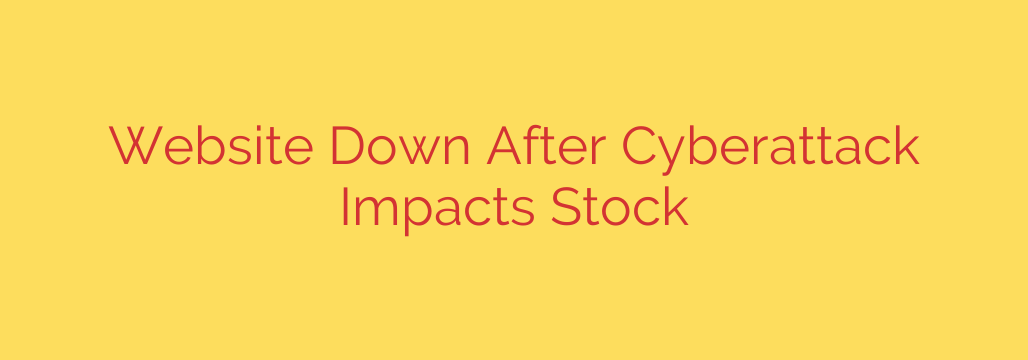
Beyond Downtime: How Cyberattacks Crush Stock Prices and Erode Trust
The digital heartbeat of a modern enterprise is its online presence. When that heartbeat stops, the consequences can be catastrophic, extending far beyond a simple “404 Not Found” error. A successful cyberattack that forces a company’s website offline is not just an IT problem—it’s a full-blown business crisis with the power to send shockwaves through the financial markets.
Recent events serve as a stark reminder of this reality. When a company’s digital doors are slammed shut by malicious actors, the fallout is immediate and public. This isn’t just about lost sales during the outage; it’s a brutal chain reaction that can devastate a company’s market value.
The Immediate Aftermath: Operational Paralysis
The first and most obvious impact of a website takedown is the complete halt of online operations. For e-commerce, media, and service-based companies, this means revenue streams instantly dry up. Customers are unable to make purchases, access their accounts, or find information, leading to frustration and confusion.
Internally, the attack causes chaos. IT and security teams scramble to identify the breach, contain the damage, and restore functionality. This all-hands-on-deck emergency pulls resources away from all other business-critical projects. The result is crippling operational disruptions that can paralyze an entire organization for days or even weeks.
The Financial Contagion: A Crisis of Confidence
While the operational shutdown is damaging, the more severe, long-term impact is financial. A public-facing outage caused by a cyberattack is a massive red flag for investors. It signals deep-seated vulnerabilities in a company’s security posture and its ability to protect its core assets.
This visible failure triggers an immediate loss of confidence. Here’s why it hits the stock price so hard:
- Perceived Weakness: A successful attack suggests weak defenses and poor risk management, making the company appear to be a risky investment.
- Future Costs: Investors immediately begin to calculate the enormous costs of recovery, including forensic investigations, system overhauls, regulatory fines, and potential lawsuits.
- Reputational Damage: The attack becomes a public relations nightmare. News travels fast, and the association between the brand and a major security failure can be difficult to shake.
The market’s reaction is often swift and unforgiving. Seeing the company as vulnerable and its future earnings at risk, investors may rush to sell off their shares, leading to plummeting stock values in a matter of hours.
The Hidden Costs: The Erosion of Customer Trust
Beyond the immediate stock market panic lies a more insidious threat: the erosion of customer trust. A website is a promise of reliability and security. When that promise is broken, customers question whether their personal and financial data is safe with the company.
Rebuilding this trust is a long and expensive process. Even after the website is restored, the company may face customer churn, reduced engagement, and a tarnished brand image that can take years to repair. This long-term damage to the brand’s reputation can ultimately be more costly than the initial stock drop.
Proactive Defense: Protecting Your Assets and Your Value
Waiting for an attack to happen is not a strategy; it’s a liability. Protecting your digital infrastructure is synonymous with protecting your company’s financial health and reputation. Here are essential, actionable steps every business must take:
Develop a Robust Incident Response (IR) Plan: Don’t just plan to prevent attacks; plan for what you will do when one succeeds. An IR plan ensures you can respond quickly and effectively to contain the breach, minimize downtime, and manage communications. A clear, well-rehearsed plan can significantly reduce panic and shorten recovery time.
Invest in Layered Security: There is no single magic bullet for cybersecurity. A strong defense requires multiple layers, including modern firewalls, Web Application Firewalls (WAF), DDoS mitigation services, endpoint protection, and regular security audits. Assume you are a target and build your defenses accordingly.
Prioritize Employee Training: Many cyberattacks begin with a single human error, such as a phishing email click. Ongoing security awareness training for all employees is one of the most cost-effective defenses you can deploy to create a human firewall.
Maintain Transparent Communication Protocols: In the event of a breach, how you communicate with stakeholders—including customers and investors—is critical. Having a crisis communication plan ready can help manage the narrative, maintain a degree of trust, and reassure the market that you have the situation under control.
Ultimately, cybersecurity can no longer be viewed as a simple IT expense. It is a fundamental component of corporate governance and risk management. An investment in robust security is an investment in business continuity, customer loyalty, and shareholder confidence. In today’s digital economy, the price of prevention is always lower than the cost of recovery.
Source: https://go.theregister.com/feed/www.theregister.com/2025/08/14/stock_in_the_channel_pulls/







